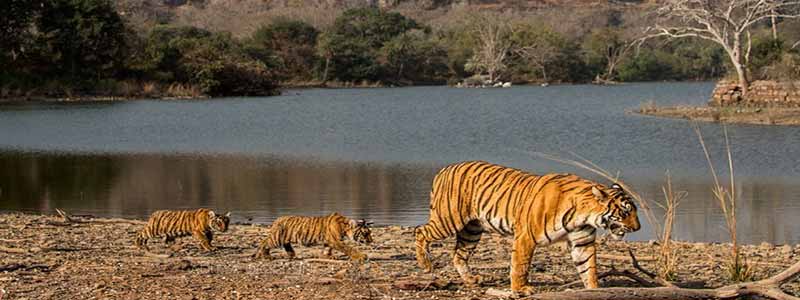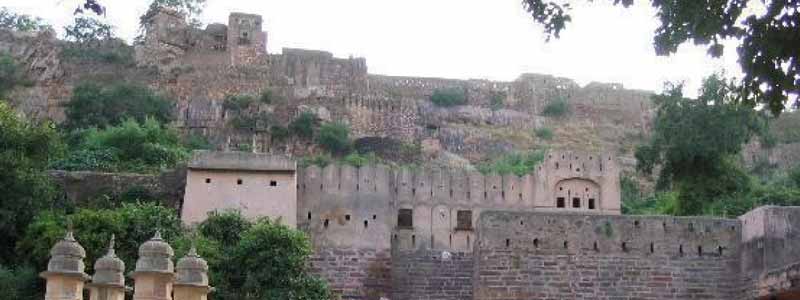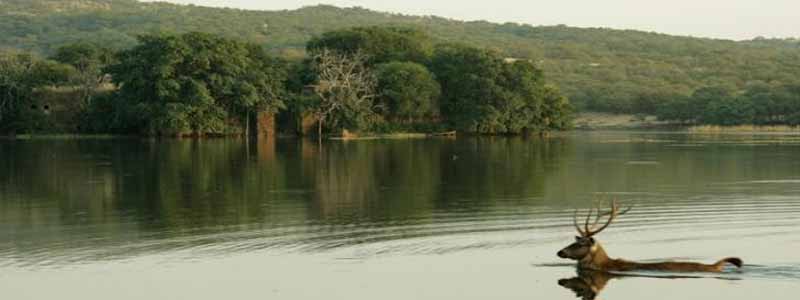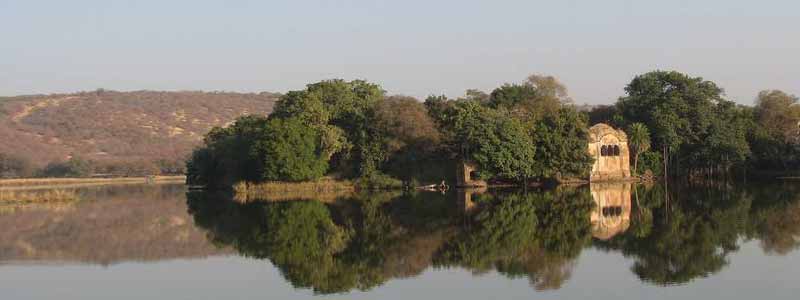Things to Do in Ranthambore, located in Rajasthan, India, is renowned for its majestic Ranthambore National Park and its historic Ranthambore Fort. Nature enthusiasts and wildlife lovers flock to the park to witness the elusive Bengal tigers, along with diverse flora and fauna. Safari tours offer a thrilling opportunity to spot these magnificent creatures in their natural habitat.
Apart from wildlife excursions, explore the ancient Ranthambore Fort, a UNESCO World Heritage Site, offering panoramic views of the surrounding landscapes. Delve into the rich history of the region while marveling at the architecture and ruins within the fort.
For a cultural experience, visit the Surwal Lake, where migratory birds gather, creating a picturesque setting for birdwatchers. The nearby village of Sawai Madhopur provides a glimpse into local life and traditional Rajasthani culture Things To Do Ranthambore.
Additionally, indulge in authentic Rajasthani cuisine at local eateries and markets. The town offers a blend of adventure, history, and culture, making Ranthambore a must-visit destination for those seeking a unique and immersive experience in India.

Ranthambore Tiger Reserve
Ranthambore Tiger Reserve, located in the Sawai Madhopur district of Rajasthan, India, spans over 1,334 square kilometers of diverse terrain, including dry deciduous forests, rocky terrain, and several lakes and rivers. Established in 1973 as a wildlife sanctuary and later declared a tiger reserve under the Project Tiger initiative in 1974, it is renowned for its thriving population of Bengal tigers.
Apart from tigers, Ranthambore is home to a rich variety of flora and fauna, including leopards, sloth bears, deer species such as sambar and spotted deer, and a vibrant birdlife with over 300 species recorded. The reserve’s rugged landscape dotted with ancient ruins, including the historic Ranthambore Fort, adds to its allure, offering a unique blend of natural beauty and cultural heritage.
Ranthambore is a popular destination for wildlife enthusiasts and photographers, offering safari experiences to observe its majestic tigers and other wildlife in their natural habitat. Conservation efforts in the reserve focus on preserving its biodiversity and ensuring the long-term survival of its flagship species, particularly the endangered Bengal tiger Ranthambore Tour Packages.

Ranthambore Fort
Ranthambore Fort, situated in the heart of the Ranthambore National Park in Rajasthan, India, is a majestic testament to the region’s rich history and architectural grandeur. Believed to have been built in the 10th century by the Chauhan dynasty, this formidable fortress stands atop a 700-foot-high hill overlooking the sprawling wilderness below.
With its imposing walls, intricately carved temples, and magnificent palaces, Ranthambore Fort served as a strategic stronghold for various rulers over the centuries, including the Mughals and the Rajputs. Its strategic location provided commanding views of the surrounding terrain, making it a formidable bastion.
Today, the fort is a UNESCO World Heritage Site, drawing visitors from around the world to marvel at its historical significance and architectural splendor. In addition to its historical allure, the fort offers breathtaking vistas of the surrounding jungle and is a popular spot for wildlife enthusiasts seeking to catch a glimpse of the majestic Bengal tiger, for which Ranthambore National Park is renowned.

Surwal Lake
Surwal Lake is a picturesque water body located near the Ranthambore National Park in the Sawai Madhopur district of Rajasthan, India. Covering an area of about 7 square kilometers, this freshwater lake is surrounded by lush greenery and serves as a vital habitat for various species of birds and wildlife.
The serene ambiance of Surwal Lake attracts nature lovers and birdwatchers from far and wide. Visitors can indulge in birdwatching activities and spot numerous migratory and resident bird species such as pelicans, cranes, storks, herons, and many more. The tranquil surroundings provide an excellent opportunity for photography enthusiasts to capture stunning shots of both birds and the scenic landscape.
Moreover, Surwal Lake offers a tranquil escape from the hustle and bustle of city life, making it a perfect spot for relaxation and rejuvenation. Visitors can also enjoy boating in the calm waters of the lake while soaking in the natural beauty that surrounds them.
Overall, Surwal Lake in Ranthambore is a haven for nature enthusiasts, offering a delightful experience amidst the serene wilderness of Rajasthan.

Trinetra Ganesh Temple
The Trinetra Ganesh Temple in Ranthambore is a revered Hindu temple nestled within the Ranthambore Fort complex in Rajasthan, India. Dedicated to Lord Ganesha, the elephant-headed deity, this ancient temple holds immense religious significance and attracts devotees from far and wide.
What sets this temple apart is its unique depiction of Lord Ganesha with three eyes, known as “Trinetra,” symbolizing his omniscience and ability to see past, present, and future. The temple’s sanctum sanctorum houses a statue of Lord Ganesha with three eyes, believed to be self-manifested.
Devotees flock to this sacred site to seek the blessings of Lord Ganesha for wisdom, prosperity, and the removal of obstacles. The temple ambiance, surrounded by serene natural beauty and the historic aura of Ranthambore Fort, adds to the spiritual experience.
Visitors can explore the temple premises, offer prayers, and participate in various religious rituals. The Trinetra Ganesh Temple stands not only as a religious landmark but also as a testament to the rich cultural heritage of Rajasthan, inviting pilgrims and tourists to witness its divine charm.

Padam Lake
Padam Lake, nestled within the renowned Ranthambore National Park in Rajasthan, India, is a serene oasis of natural beauty and biodiversity. Spread over a vast area, this picturesque lake serves as a vital watering hole for numerous species of wildlife inhabiting the park, including the majestic Bengal tiger, leopards, sloth bears, and various species of deer and birds.
The tranquil waters of Padam Lake reflect the surrounding lush greenery, creating a mesmerizing ambiance for visitors. It’s a popular spot for wildlife enthusiasts and photographers seeking to capture stunning glimpses of wildlife against the backdrop of the serene lake.
Apart from its scenic charm, Padam Lake plays a crucial role in the ecosystem of Ranthambore National Park by sustaining the diverse flora and fauna that depend on its water source. Visitors can explore the area through safari tours offered by the park authorities, allowing them to immerse themselves in the natural splendor of Padam Lake while observing its rich wildlife in their natural habitat.
Kachida Valley
Kachida Valley, situated within Ranthambore National Park in Rajasthan, India, is a picturesque landscape renowned for its diverse wildlife and stunning natural beauty. Spanning approximately 10 square kilometers, this valley is characterized by rugged terrain, rocky outcrops, and dense vegetation, creating an ideal habitat for a wide array of flora and fauna.
One of the most notable features of Kachida Valley is its significance as a prime tiger territory. It serves as a crucial corridor for tigers moving between different parts of the park, offering visitors a unique opportunity to spot these majestic big cats in their natural habitat. Apart from tigers, the valley is also home to other wildlife species such as leopards, sloth bears, sambar deer, and a variety of bird species, making it a paradise for wildlife enthusiasts and photographers.
Visitors can explore Kachida Valley through guided safaris conducted by the forest department, allowing them to immerse themselves in the wilderness and witness the beauty of this rugged landscape while experiencing the thrill of encountering its rich wildlife population.
Jogi Mahal
Jogi Mahal is a historic structure located in the Ranthambore National Park, situated in the Sawai Madhopur district of Rajasthan, India. This architectural gem dates back to the 16th century and is known for its intricate designs and cultural significance.
Constructed during the reign of Emperor Akbar, Jogi Mahal served as a hunting lodge for the royals of Rajasthan. It is built using red sandstone, a common feature of Mughal architecture, and showcases elements of both Mughal and Rajput styles.
Aside from its architectural beauty, Jogi Mahal holds historical importance as it is believed to have been a resting place for the renowned Saint Jogi during his spiritual journeys. The lush surroundings and serene ambiance make it a popular spot for tourists visiting Ranthambore National Park.
Today, Jogi Mahal stands as a testament to the rich heritage of Rajasthan and continues to attract visitors from around the world, offering them a glimpse into the region’s royal past and architectural grandeur within the tranquil setting of the national park.
Wild Dragon Adventure Park
Wild Dragon Adventure Park, located in Ranthambore, is a thrilling destination for adventure enthusiasts and nature lovers alike. Spread across acres of lush greenery, this park offers a plethora of exciting activities amidst the backdrop of the majestic Ranthambore National Park.
Visitors to Wild Dragon Adventure Park can indulge in a variety of adrenaline-pumping experiences such as zip-lining through the dense forests, rock climbing on natural rock formations, and rappelling down rugged cliffs. The park also features challenging obstacle courses that test both physical strength and mental agility.
For those seeking a more serene experience, Wild Dragon Adventure Park provides nature trails where guests can immerse themselves in the beauty of the surrounding wilderness and observe indigenous flora and fauna.
Additionally, the park offers comfortable accommodation options for overnight stays, allowing guests to extend their adventure and fully immerse themselves in the natural splendor of Ranthambore.
Whether you’re a thrill-seeker or a nature enthusiast, Wild Dragon Adventure Park promises an unforgettable experience amidst the breathtaking landscapes of Ranthambore.
Raj Bagh Ruins
The Raj Bagh Ruins in Ranthambore, India, stand as silent witnesses to a bygone era, offering a glimpse into the region’s rich history and architectural heritage. Located within the Ranthambore National Park, these ancient ruins date back centuries, with origins tracing to the majestic Rajput dynasty.
Amidst the lush greenery and rugged terrain of the national park, the Raj Bagh Ruins exude a mystical charm, inviting visitors to explore their crumbling structures and intricate carvings. The site is believed to have once been a grand palace or hunting lodge, serving as a retreat for royalty and nobility.
Today, the ruins provide a hauntingly beautiful backdrop for wildlife enthusiasts and history buffs alike, offering a unique blend of natural splendor and cultural significance. Visitors can wander through the remnants of courtyards, halls, and chambers, imagining the grandeur of the past while surrounded by the sights and sounds of the present-day wilderness.
For adventurers seeking to delve into the mysteries of India’s royal past, the Raj Bagh Ruins in Ranthambore present an unforgettable journey through time and nature.
Malik Talao
Malik Talao, nestled within the Ranthambore National Park in India, is a picturesque water body renowned for its scenic beauty and rich biodiversity. Spread over an area of approximately 4.4 square kilometers, Malik Talao forms an integral part of the park’s ecosystem, providing a vital source of water for its inhabitants, especially during the scorching summer months.
Surrounded by dense foliage and rocky outcrops, Malik Talao offers a serene ambiance, attracting a diverse array of wildlife, including numerous bird species, mammals, and reptiles. Visitors to the park often flock to Malik Talao for its tranquil atmosphere and opportunities for wildlife viewing and birdwatching.
Moreover, the tranquil waters of Malik Talao serve as a perfect mirror, reflecting the surrounding landscape and enhancing the scenic charm of the area, making it a favorite spot for photographers and nature enthusiasts.
Conservation efforts aimed at preserving the natural habitat around Malik Talao are ongoing, ensuring that future generations can continue to enjoy its pristine beauty and diverse wildlife.
Rajiv Gandhi Regional Museum Of Natural
The Rajiv Gandhi Regional Museum of Natural History in Ranthambore is an institution dedicated to promoting environmental awareness and conservation. Located near the famous Ranthambore National Park in Rajasthan, India, the museum offers visitors a unique opportunity to explore the region’s rich biodiversity and natural heritage.
Opened in 2007, the museum is named after former Prime Minister of India, Rajiv Gandhi, and is managed by the Ministry of Environment, Forest and Climate Change. It features various exhibits, interactive displays, and educational programs aimed at raising awareness about the importance of preserving natural ecosystems and wildlife.
Visitors to the museum can learn about the diverse flora and fauna found in the Ranthambore region, including its iconic Bengal tigers, leopards, sloth bears, and a variety of bird species. The museum also highlights the significance of conservation efforts in protecting endangered species and maintaining ecological balance.
Through its engaging exhibits and informative initiatives, the Rajiv Gandhi Regional Museum of Natural History serves as a vital resource for both locals and tourists interested in understanding and appreciating the natural wonders of Ranthambore.
Akaula Region
The Akaula Region in Ranthambore National Park is a captivating wilderness sanctuary nestled in the heart of Rajasthan, India. Spread across a vast expanse of approximately 180 square kilometers, this region is renowned for its rich biodiversity and majestic landscapes.
Within the Akaula Region, visitors can immerse themselves in the enchanting beauty of diverse ecosystems, ranging from dense forests to open grasslands, interspersed with tranquil water bodies. The region is celebrated for its thriving population of wildlife, including the iconic Bengal tiger, which roams freely in its natural habitat.
Exploring the Akaula Region offers nature enthusiasts and wildlife photographers unparalleled opportunities to observe and capture mesmerizing moments amidst the raw wilderness. Whether it’s witnessing a tiger stealthily maneuvering through the foliage or marveling at the graceful movements of rare bird species, every moment spent in this region is a testament to the awe-inspiring wonders of nature.
Moreover, the Akaula Region is not only a haven for wildlife but also serves as a vital conservation area dedicated to preserving endangered species and their habitats. Through responsible tourism and conservation efforts, this pristine wilderness continues to thrive, captivating the hearts and minds of all who venture into its realm.
Ranthambore School of Art
The Ranthambore School of Art, nestled in the scenic landscape of the Ranthambore National Park in Rajasthan, India, stands as a beacon of artistic expression deeply rooted in nature. Founded with a vision to blend artistic endeavors with environmental conservation, this unique institution offers a platform for aspiring artists to explore their creativity amidst the rich biodiversity of the region.
At the Ranthambore School of Art, students immerse themselves in a curriculum that seamlessly integrates traditional art techniques with contemporary environmental themes. From capturing the majestic beauty of tigers to depicting the intricate ecosystem of the forest, every stroke of the brush embodies a deep connection to nature.
Under the guidance of skilled mentors who are passionate about both art and wildlife conservation, students develop not only their artistic skills but also a profound appreciation for the natural world. Through exhibitions, workshops, and community outreach programs, the school actively contributes to raising awareness about environmental issues and the importance of preserving the wilderness.
In this picturesque setting where art meets nature, the Ranthambore School of Art inspires future generations of artists to become ambassadors for conservation through their creative expressions.
Village of Women Craft
Ranthambore, nestled in the heart of India, is renowned for its majestic wildlife and ancient history. However, amidst the wilderness lies a hidden gem – the Village of Women Craft.
Situated on the outskirts of Ranthambore National Park, this village is home to a community of skilled female artisans who have preserved and perfected traditional crafts passed down through generations. From intricate embroidery to vibrant block printing, the women of this village showcase their talent and dedication through their exquisite handcrafted creations.
Visitors to the Village of Women Craft are not only treated to a glimpse of Rajasthan’s rich cultural heritage but also have the opportunity to support sustainable and ethical practices. Each purchase directly contributes to empowering these women economically and socially, enabling them to become self-reliant entrepreneurs.
Beyond being a marketplace, the village serves as a symbol of women’s resilience and ingenuity in rural India. It stands as a testament to the transformative power of artisanship, community, and heritage preservation in uplifting lives and fostering sustainable development in the heart of Ranthambore.








